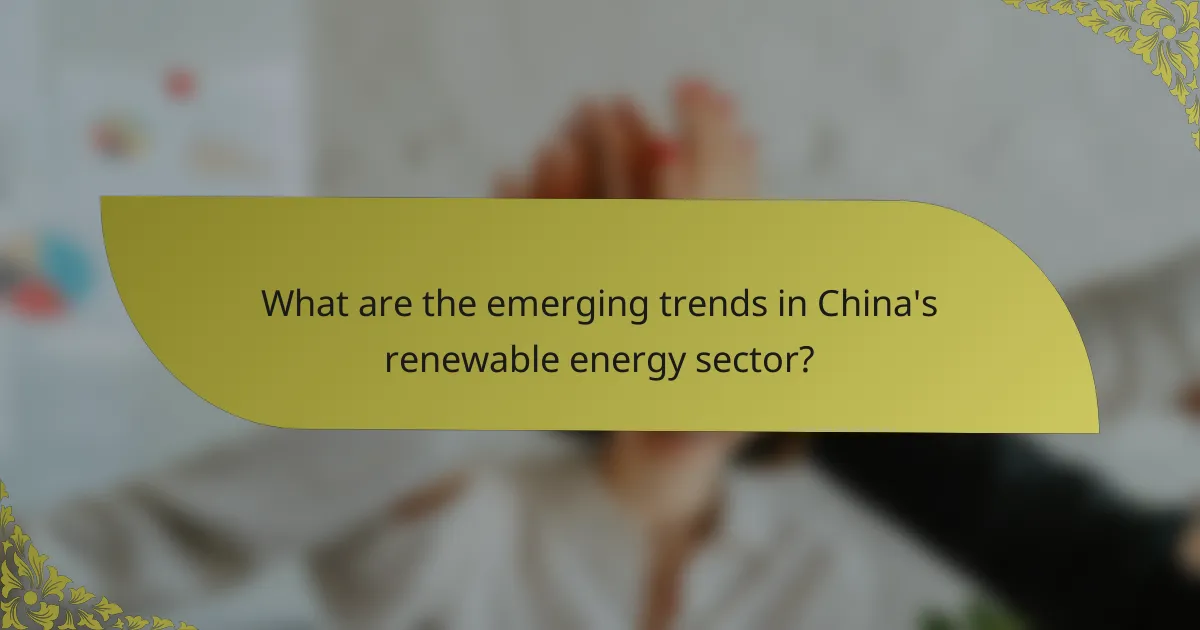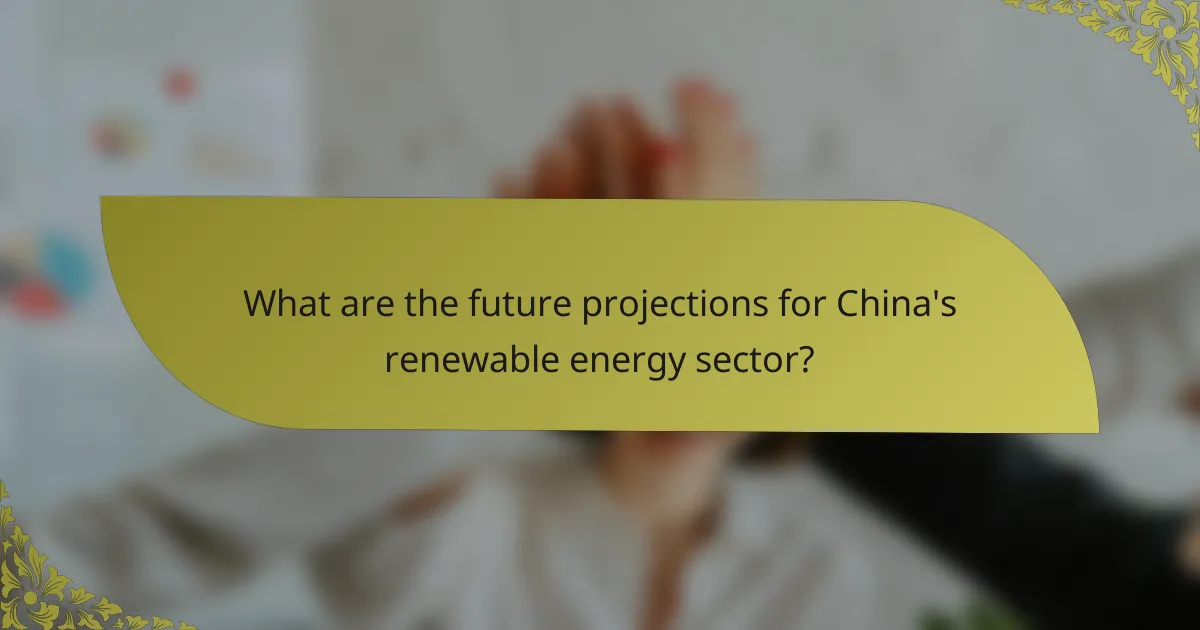China’s renewable energy sector is experiencing transformative growth, driven by advancements in solar and wind technologies. The country leads global solar panel production, contributing over 30% of the world’s capacity, while also becoming the largest market for wind power installations. Key trends include increased investment in energy storage and a focus on hydrogen energy, supported by evolving government policies aimed at achieving carbon neutrality by 2060. The global context, including international climate agreements and geopolitical dynamics, further influences China’s renewable energy strategies. As a result, the sector is projected to attract significant investments and expand its capacity substantially by 2030.

What are the emerging trends in China’s renewable energy sector?
China’s renewable energy sector is experiencing significant emerging trends. These include rapid advancements in solar and wind energy technologies. The country is leading the world in solar panel production, with over 30% of global capacity. Wind energy installations are also surging, making China the largest market for wind power.
Another trend is the increasing investment in energy storage solutions. Battery technology improvements are essential for integrating renewable sources into the grid. Additionally, China is focusing on hydrogen energy, aiming to become a leader in hydrogen production and fuel cell technology.
Government policies are also evolving to support these trends. Initiatives like the “14th Five-Year Plan” prioritize renewable energy development. These policies aim for carbon neutrality by 2060, driving further investment and innovation.
Overall, China’s renewable energy sector is at the forefront of global developments, marked by technological advancements and strategic government support.
How are technological innovations shaping the renewable energy landscape in China?
Technological innovations are significantly shaping the renewable energy landscape in China. These innovations include advancements in solar panel efficiency and wind turbine design. For instance, China has developed solar panels that convert over 25% of sunlight into electricity. This is a notable increase from earlier technologies. Additionally, the country leads in the production of wind turbines, with designs that maximize energy capture in varying wind conditions.
The integration of smart grid technology further enhances energy management. Smart grids allow for real-time monitoring and distribution of renewable energy. This optimizes energy use and reduces waste. Furthermore, energy storage technologies, such as lithium-ion batteries, are being improved to store excess energy generated from renewable sources.
China’s investment in research and development supports these technological advancements. In 2020, China invested over $83 billion in renewable energy technologies. This investment fosters innovation and positions China as a leader in the global renewable energy market. Overall, technological innovations are driving efficiency, capacity, and sustainability in China’s renewable energy sector.
What specific technologies are leading the charge in renewable energy advancements?
Solar photovoltaic (PV) technology is a leading force in renewable energy advancements. It converts sunlight directly into electricity using semiconductor materials. In 2022, global solar capacity reached over 1,000 GW, showcasing rapid growth. Wind energy technology, particularly onshore and offshore wind farms, is also significant. Wind turbines harness kinetic energy from wind to generate electricity. In 2021, wind energy accounted for about 8.7% of global electricity production. Energy storage technologies, especially lithium-ion batteries, are crucial for balancing supply and demand. These batteries store excess energy for use during peak times. Hydrogen fuel cells are gaining traction as a clean energy source. They convert hydrogen and oxygen into electricity, emitting only water vapor. Geothermal energy systems are utilizing heat from the Earth’s core for sustainable power. This technology provides a stable energy source with low emissions. Together, these technologies are transforming the renewable energy landscape.
How do these innovations impact energy efficiency and sustainability?
Innovations in China’s renewable energy sector significantly enhance energy efficiency and sustainability. These advancements include improved solar panel technology, which increases energy conversion rates. For instance, bifacial solar panels can capture sunlight from both sides, boosting output by up to 30%. Wind turbine innovations, such as larger blades and advanced materials, allow for greater energy capture in low-wind conditions. Energy storage technologies, like lithium-ion batteries, enable better integration of intermittent renewable sources. According to a report by the International Renewable Energy Agency, renewable energy technologies can reduce greenhouse gas emissions by up to 70% by 2050. Overall, these innovations contribute to a more sustainable energy landscape by reducing reliance on fossil fuels and lowering carbon footprints.
What challenges does China’s renewable energy sector face?
China’s renewable energy sector faces several significant challenges. One major challenge is the integration of renewable energy into the existing power grid. The grid infrastructure often struggles to accommodate the variable output from sources like solar and wind. Additionally, there are issues related to energy storage technologies. Current storage solutions are not sufficient to balance supply and demand effectively.
Another challenge is the reliance on fossil fuels, which still dominate China’s energy mix. Despite investments in renewables, coal remains a primary energy source. Policy and regulatory frameworks also pose challenges. Inconsistent policies can hinder investment and development in renewable projects.
Moreover, there are concerns about resource availability and environmental impacts. The production of renewable technologies can lead to resource depletion and pollution. Lastly, competition from other countries in the renewable sector can affect China’s market position. These challenges collectively hinder the growth and efficiency of China’s renewable energy sector.
What regulatory hurdles are impacting renewable energy projects?
Regulatory hurdles impacting renewable energy projects include complex permitting processes and inconsistent policies. These challenges can delay project timelines significantly. Local governments often have varying regulations that complicate compliance. Additionally, lack of clear guidelines can lead to uncertainty for investors. Grid connection issues also pose a significant barrier for many renewable projects. Furthermore, financial incentives may not be uniformly available, hindering project viability. According to a report by the International Renewable Energy Agency, regulatory uncertainty remains a top concern for renewable energy developers.
How do financial constraints affect the growth of renewable energy initiatives?
Financial constraints significantly hinder the growth of renewable energy initiatives. Limited funding restricts the development and deployment of new technologies. Without adequate investment, projects may face delays or cancellations. Financial barriers also lead to higher costs for consumers and businesses. According to the International Renewable Energy Agency, investment in renewable energy must reach $2 trillion annually to meet global climate targets. In China, financial limitations impede the transition from coal to renewable sources. This affects the overall energy mix and sustainability goals. Thus, financial constraints pose a critical challenge to the advancement of renewable energy initiatives.
What market opportunities exist within China’s renewable energy sector?
China’s renewable energy sector presents significant market opportunities. The country is the largest producer of solar panels and wind turbines globally. The government aims to achieve carbon neutrality by 2060, driving demand for renewable technologies. Investments in solar and wind energy projects are expected to grow substantially. The electric vehicle market is expanding, creating opportunities for battery production and charging infrastructure. Energy storage solutions are in high demand to enhance grid stability. Additionally, there is potential for innovation in smart grid technology. These factors indicate a robust growth trajectory for the renewable energy sector in China.
Which sectors are ripe for investment and development in renewable energy?
The sectors ripe for investment and development in renewable energy include solar power, wind energy, and energy storage technologies. Solar power continues to grow, driven by decreasing costs and government incentives. Wind energy has significant potential, particularly in offshore installations. Energy storage technologies are crucial for managing supply and demand. According to the International Energy Agency, solar and wind combined could account for over 70% of global electricity generation by 2050. Additionally, China is leading in solar panel production and wind turbine manufacturing, making these sectors particularly attractive for investment.
How can international partnerships enhance China’s renewable energy capabilities?
International partnerships can significantly enhance China’s renewable energy capabilities. Collaborations with foreign entities can facilitate the transfer of advanced technologies. For instance, partnerships with countries like Germany and Denmark have led to innovations in wind energy technologies. These collaborations allow for knowledge sharing and best practices in renewable energy development. Access to international funding can also support large-scale renewable projects in China. Additionally, partnerships can open up new markets for Chinese renewable energy products. This can lead to increased exports and economic growth. Overall, international partnerships can accelerate China’s transition to a more sustainable energy future.

How is the global context influencing China’s renewable energy trends?
The global context is significantly influencing China’s renewable energy trends. International climate agreements, such as the Paris Agreement, prompt China to enhance its renewable energy commitments. Global demand for clean energy technologies drives investments in solar and wind energy sectors. Geopolitical tensions, particularly with the U.S., encourage China to reduce reliance on fossil fuels. The global shift towards sustainability influences domestic policies and incentives for renewable energy development. Additionally, international collaborations in technology and research foster innovation within China’s renewable energy landscape. China’s role as a leading manufacturer of solar panels and wind turbines is shaped by global market dynamics. These factors collectively drive China’s transition towards a more sustainable energy future.
What role does international policy play in shaping China’s renewable energy strategies?
International policy significantly influences China’s renewable energy strategies. Global agreements, such as the Paris Agreement, compel China to commit to emissions reduction targets. These international commitments drive investment in clean energy technologies. Additionally, foreign partnerships enhance technology transfer and innovation in renewable sectors. China’s participation in global climate forums shapes its domestic policies and funding priorities. The Belt and Road Initiative also promotes renewable energy projects in partner countries, aligning with international sustainability goals. Consequently, international policy acts as a catalyst for China’s renewable energy development and implementation.
How do global climate agreements affect China’s energy transition?
Global climate agreements significantly influence China’s energy transition. These agreements, such as the Paris Agreement, set binding targets for carbon emissions reduction. China, as a major global emitter, commits to peak carbon emissions before 2030 and achieve carbon neutrality by 2060. This commitment drives investments in renewable energy technologies. In 2020, China led the world in solar and wind capacity installations, reflecting its response to international climate commitments. The government also implements policies to promote electric vehicles and energy efficiency. Additionally, compliance with global standards enhances China’s technological advancements. These factors collectively accelerate China’s shift toward a sustainable energy future.
What lessons can be learned from other countries’ renewable energy experiences?
Countries’ renewable energy experiences reveal several key lessons. Successful policy frameworks encourage investment and innovation. For example, Germany’s feed-in tariff system significantly boosted solar energy adoption. The integration of diverse energy sources enhances grid stability, as seen in Denmark’s wind energy strategy. Public engagement and education promote acceptance and participation in renewable initiatives. Countries like Sweden demonstrate the importance of long-term planning and commitment to sustainability goals. Collaborative international efforts can accelerate technology transfer and knowledge sharing. These lessons underscore the need for tailored approaches that consider local contexts and resources.
Which countries serve as successful models for renewable energy adoption?
Germany, Denmark, and Sweden serve as successful models for renewable energy adoption. Germany leads with its Energiewende policy, aiming for 80% renewable energy by 2050. It has invested heavily in solar and wind energy. Denmark generates over 47% of its electricity from wind power. This success stems from strong government support and innovative technology. Sweden aims to be fossil fuel-free by 2045, utilizing hydropower and bioenergy. These countries showcase effective policies and technologies that promote renewable energy.

What are the future projections for China’s renewable energy sector?
China’s renewable energy sector is projected to continue its rapid growth. By 2030, China aims to have 1,200 gigawatts of solar and wind capacity. This goal aligns with its commitment to peak carbon emissions before 2030. According to the International Energy Agency, China accounted for over 50% of global renewable energy investment in 2020. The sector is expected to attract significant investment, estimated at $16 trillion by 2030. Additionally, advancements in technology will enhance efficiency and reduce costs. The government is also implementing policies to support energy transition. These factors contribute to a robust outlook for China’s renewable energy sector.
How is market demand expected to evolve in the coming years?
Market demand for renewable energy in China is expected to increase significantly in the coming years. This growth is driven by government policies promoting clean energy and reducing carbon emissions. The Chinese government aims to achieve carbon neutrality by 2060, which will boost investments in renewable technologies. Additionally, technological advancements are making renewable energy sources more efficient and cost-effective. According to a report by the International Energy Agency, China’s renewable energy capacity could exceed 1,200 GW by 2025. Increased public awareness of environmental issues is also fueling demand for sustainable energy solutions. As a result, market demand will likely evolve towards greater adoption of solar, wind, and other renewable sources.
What are the anticipated technological advancements in the near future?
Anticipated technological advancements in the near future include significant improvements in renewable energy technologies. Innovations in solar panel efficiency are expected, with some researchers predicting increases up to 30% in conversion rates. Wind energy technologies will likely see advancements in turbine design, enhancing energy capture and reducing costs. Energy storage solutions, particularly battery technology, are anticipated to improve, allowing for longer storage durations and greater capacity. Smart grid technologies will also evolve, enabling more efficient energy distribution and management. These advancements are supported by increasing investments in clean energy, projected to reach over $500 billion annually by 2025.
What strategies can stakeholders implement to navigate the renewable energy landscape?
Stakeholders can implement several strategies to navigate the renewable energy landscape effectively. First, they should invest in research and development to drive innovation. This can lead to improved technologies and increased efficiency in energy production. Second, collaboration with government entities is essential for aligning policies with industry needs. Engaging in public-private partnerships can facilitate access to funding and resources. Third, stakeholders should focus on diversifying energy portfolios. This minimizes risks associated with market fluctuations and regulatory changes. Additionally, adopting flexible business models can enhance adaptability to evolving market conditions. Finally, stakeholders must prioritize sustainability and social responsibility. This approach not only meets regulatory requirements but also builds consumer trust. These strategies are supported by the increasing demand for clean energy solutions globally, as evidenced by China’s commitment to achieving carbon neutrality by 2060.
What best practices should companies adopt for successful project implementation?
Companies should adopt clear communication, stakeholder engagement, and thorough planning for successful project implementation. Clear communication ensures all team members understand their roles and responsibilities. Stakeholder engagement builds support and addresses concerns early in the process. Thorough planning includes setting realistic timelines and budgets. Research indicates that projects with defined goals and measurable outcomes are more likely to succeed. A study by the Project Management Institute found that organizations with effective communication practices are 50% more likely to complete projects on time and within budget.
How can stakeholders effectively collaborate to overcome industry challenges?
Stakeholders can effectively collaborate to overcome industry challenges by fostering open communication and establishing clear goals. Regular meetings and joint workshops can facilitate the sharing of insights and resources. Collaborative platforms can be utilized to streamline information exchange. Stakeholders should also engage in co-developing solutions to address specific challenges. Joint ventures and partnerships can enhance innovation and resource pooling. Evidence shows that industries with high stakeholder collaboration report a 30% increase in project success rates. Additionally, studies indicate that collaborative approaches can reduce costs by up to 25%.
What are the key takeaways for investors in China’s renewable energy sector?
Investors in China’s renewable energy sector should focus on growth potential and government support. The sector is projected to grow significantly, with renewable energy capacity expected to reach 1,200 GW by 2030. China’s commitment to carbon neutrality by 2060 drives investment opportunities. The government offers incentives for solar, wind, and hydroelectric projects. Investors should also consider technological advancements in energy storage and grid integration. Market competition is increasing, leading to innovation and cost reductions. Understanding regulatory frameworks is crucial for navigating investment risks. Finally, collaboration with local partners can enhance market entry and operational efficiency.
The main entity of the article is China’s renewable energy sector, which is currently witnessing significant advancements and trends. Key topics covered include the rapid growth of solar and wind energy technologies, increasing investments in energy storage solutions, and the country’s focus on hydrogen energy. The article also discusses the challenges faced by the sector, such as regulatory hurdles and financial constraints, while highlighting market opportunities driven by government policies and international collaborations. Additionally, it examines the impact of technological innovations on energy efficiency and sustainability, along with future projections for growth in China’s renewable energy landscape.



